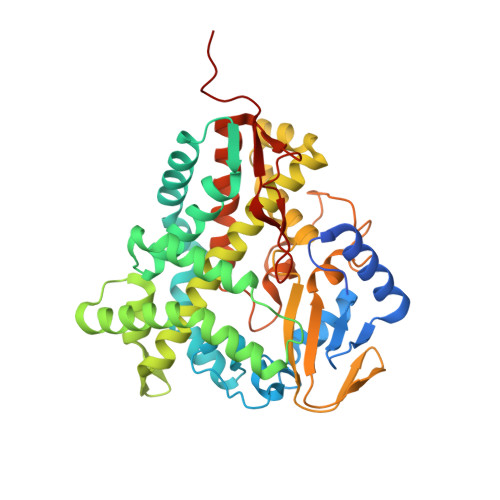Redirecting P450 Eryk Specificity by Rational Site-Directed Mutagenesis.
Montemiglio, L.C., Macone, A., Ardiccioni, C., Avella, G., Vallone, B., Savino, C.(2013) Biochemistry 52: 3678
- PubMed: 23597312
- DOI: https://doi.org/10.1021/bi400223j
- Primary Citation of Related Structures:
3ZKP - PubMed Abstract:
The C-12 hydroxylase EryK is a bacterial cytochrome P450, active during one of the final tailoring steps of erythromycin A (ErA) biosynthesis. Its tight substrate specificity, restricted to the metabolic intermediate ErD, leads to the accumulation in the culture broth of a shunt metabolite, ErB, that originates from the competitive action of a methyltranferase on the substrate of EryK. Although the methylation of the mycarosyl moiety represents the only difference between the two metabolites, EryK exhibits very low conversion of ErB in ErA via a parallel pathway. Given its limited antimicrobial activity and its moderate toxicity, contamination by such a byproduct decreases the yield and purity of the antibiotic. In this study, EryK has been redesigned to make it suitable for industrial application. Taking advantage of the three-dimensional structure of the enzyme in complex with ErD, three single active-site mutants of EryK (M86A, H88E, and E89L) have been designed to allow hydroxylation of the nonphysiological substrate ErB. The binding and catalytic properties of these three variants on both ErD and ErB have been analyzed. Interestingly, we found the mutation of Met 86 to Ala to yield enzymatic activity on both ErB and ErD. The three-dimensional structure of the complex of mutated EryK with ErB revealed that the mutation allows ErB to accommodate in the active site of the enzyme and to induce its closure, thus assuring the progress of the catalytic reaction. Therefore, by single mutation the fine substrate recognition, active site closure, and locking were recovered.
Organizational Affiliation:
Istituto Pasteur-Fondazione Cenci Bolognetti and Istituto di Biologia e Patologia Molecolari del CNR, Dipartimento di Scienze Biochimiche "A. Rossi Fanelli", Sapienza Universit¨¤ di Roma , Piazzale A. Moro 5, 00185 Rome, Italy.
















